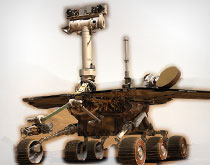
More than 35 million miles from Earth, a pair of 400-pound remote-controlled vehicles were stuck. Mars exploration rovers Spirit and Opportunity landed on the Red Planet in 2004, equipped with well-designed navigation systems. The mission was designed to last for 90 Martian days, but because the rovers were behaving so well, their exploring and cataloguing of Mars continued.
Suddenly, movement came to a halt.
NASA researcher Mark Maimone (S’87, CS’96) knew what to do. His robotics experience at Carnegie Mellon pointed him to Field D* global path selection software developed by Tony Stentz (S’84, CS’90), Carnegie Mellon research professor and current director of CMU’s National Robotics Engineering Center.
Field D*, an algorithm, similar to ones programmers use to control drones in video games, can compute on the fly in unknown terrain, continuously adding data to plot the best path for a vehicle. Stentz and former student Dave Ferguson (CS’04, ’06) built a compact version of the software they developed to work on the tiny 20 MHz CPU used by the solar-powered rovers. Maimone’s team uploaded it directly to Spirit and Opportunity and the mission resumed, completing a series of long-range trips, including a 12-mile traverse from Victoria Crater to Endeavour Crater.
Today, NASA has a new, larger rover sniffing out water and microbes on Mars. Curiosity touched down safely in August with Field D* at the ready. —Shannon Gazze



